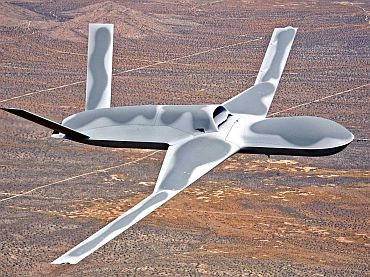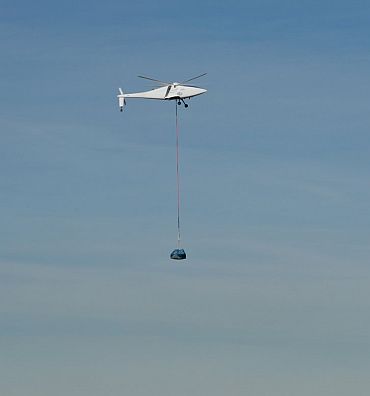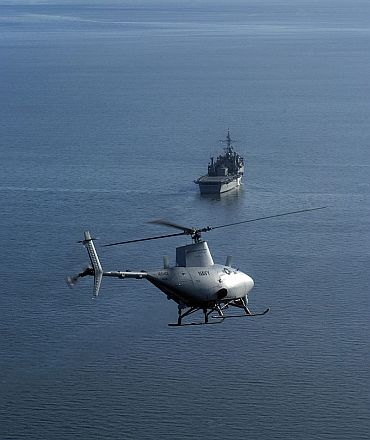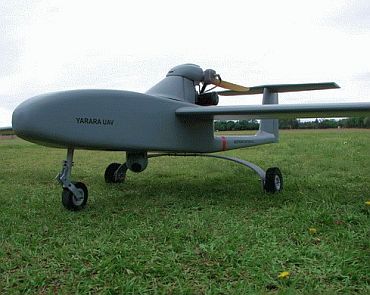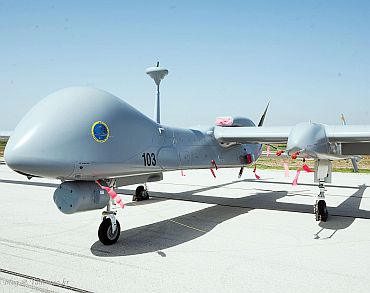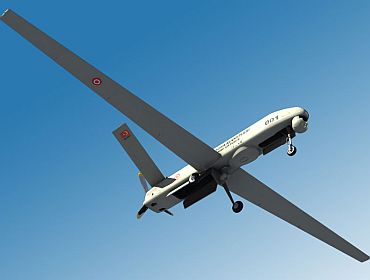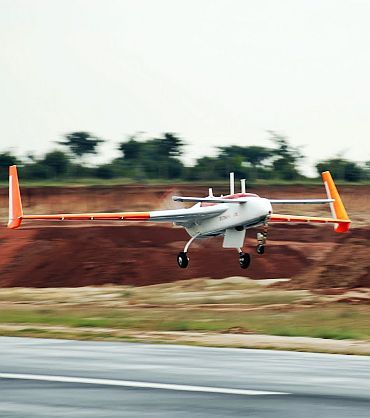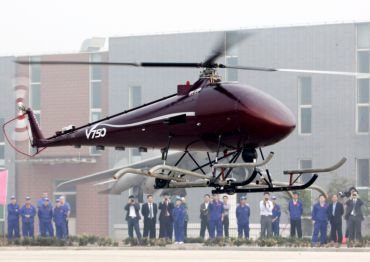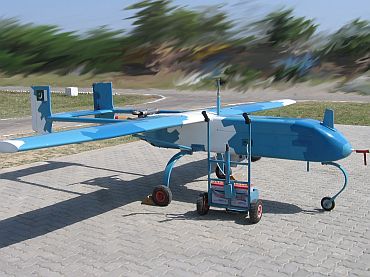 | « Back to article | Print this article |
World's best unmanned predators
Unmanned Aerial Vehicles are being used in a reconnaissance and intelligence-gathering role since the 1950s. Over the years, they have also assumed more challenging roles are envisioned, including combat missions.
The remotely piloted aircraft, which can carry cameras, sensors, communications equipment or other payloads, offer the possibility of cheaper and more capable fighting machines that could be used without risk to aircrews.
While UAVs today have greater prominence in civilian operations, their armed compatriots -- known as Unmanned Combat Air Vehicle of UCAV -- are setting the tone for the modern age of warfare.
Let's take a look at some of the best unmanned aircraft in operation today.
Click on NEXT to go further...
MQ-1B Predator (United States)
The MQ-1B Predator is a medium-altitude, long-endurance, unmanned aircraft system. The Predator's primary missions are close air support, air interdiction, and intelligence, surveillance and reconnaissance, or ISR.
The MQ-1B Predator carries the Multi-spectral Targeting System, or MTS-A, which integrates an infrared sensor, a color/monochrome daylight TV camera, an image-intensified TV camera, a laser designator and a laser illuminator into a single package
The aircraft can employ two laser-guided AGM-114 Hellfire missiles which possess a highly accurate, low collateral damage, and anti-armor and anti-personnel engagement capability.
The system can be deployed for worldwide operations. The Predator aircraft can be disassembled and loaded into a container for travel. The ground control system and PPSL are transportable in a C-130 Hercules (or larger) transport aircraft. The Predator can operate on a 5,000 by 75 foot (1,524 meters by 23 meters) hard surface runway with clear line-of-sight to the ground data terminal antenna.
Avenger (United States)
Formerly known as the Predator C, the stealthy Avenger is designed to fly a 20 hour mission. The Avenger is designed to operate at altitude up to 60,000 ft.
The unmanned aircraft can take different payloads weighing up to 3,000 lbs., including EO, radar, and electronic payloads, as well as weapons (typical weapons carried could include GBU-38 Laser/JDAM), stored in an internal weapons bay and underwing. For stealthy missions all weapons are carried internally.
With a 41-foot long fuselage and 66-foot wingspan, the Avenger can fly at over 400 knots -- 50 per cent faster than the turboprop-powered Reaper unmanned plane, and more than three times as quick as the Predator.
A160 Hummingbird (United States)
The A160 Hummingbird Unmanned Aerial Vehicle looks like a helicopter but is unlike any other helicopter on the market today.
The Hummingbird is designed to fly 2,500 nautical miles with endurance in excess of 24 hours and a payload of more than 300 pounds. The autonomously-flown A160 is 35 feet long with a 36-foot rotor diameter. It will fly at an estimated top speed of 140 knots at ceilings up to 30,000 feet, which is about 10,000 feet higher than conventional helicopters can fly today.
The A160T/ MQ-18 features a unique hingeless, rigid, optimum-speed rotor technology concept (OSRT). It significantly improves overall performance efficiency by adjusting the rotor's speed at different altitudes, gross weights and cruise speeds.
There are even reports that the A160T's OSRT rotor can operate between 150-350 rpm, with tip speeds as low as Mach 0.25, instead of regular heliblade tip speeds near Mach 1. Since noise is partly a function of tip speed, a slow-turning A160T would have another big advantage over normal helicopters and VTUAVs: it would be much quieter
RQ-8A (United States)
The RQ-8A is based on the Schweizer Model 330SP manned light helicopter.
It is powered by a derated Rolls-Royce/Allison 250-C20W turboshaft engine which drives a three-bladed rotor.
The blades can be folded for compact stowage of the UAV.
The Fire Scout is equipped with a GPS-based navigation system for autonomous operations, and the GCS (Ground Control Station) can control three UAVs simultaneously. The line-of-sight range of the Ku-Band TCDL (Tactical Common Datalink) is about 280 km (150 nm).
The payload for the reconnaissance and targeting mission is an integrated Northrop Grumman EO/IR/LDRF (Electro-Optical/Infrared/Laser Designator & Rangefinder) system.
Yarara (Argentina)
The Yarara is a low cost solution for tactical UAV requirements. A rugged, modular and easy to deploy system, combines in a single airframe several options in the military, security and civilian markets.
The unique concept of an integral propulsion unit allows a high sortie rate, easy field maintenance. The Yarara delivers real-time color or infrared imagery to the ground control and remote viewing stations. Other payloads could install on demand.
The Yarara system (3 UAV, GCS and support equipment) in three boxes weighting less than 250 kg allows a fast deployment and high mobility in small vehicles or helicopters to the operation area.
The Yarara can be operate in several operations mode, manually, assisted manual or programmed for autonomous operation, utilising advanced avionics and precise GPS navigation. Its landing gear design allows hard landings and improve the operation safety in heavy cross wind scenarios.
With a wingspan of 4 meters and a maximum take of weight of 30 kg . The Yarara provides aerial observation, day or night, at line-of-sight ranges more than up to 50 kilometers.
Eitan (Israel)
Heron TP, also known as the Eitan is now operational with the Israel Air Force (IAF).
The Eitan has a wingspan of approximately 26 meters (similar to the wingspan of a Boeing 737 aircraft or the Northrop Grumman RQ4 Global Hawk) and is designed to meet the demanding civil aviation authorities' certification requirements in force both in Israel and internationally.
The Eitan can perform long-range missions of over 1000km and can remain airborne for over 24 consecutive hours.
The UAV has a powerful turbo-prop engine (1200 horsepower), which allows it to reach altitudes of over 41,000 feet -- higher than commercial aircraft normally fly.
Takeoff weight is 5 tons and has the ability to carry payloads weighing approximately 1000 kg.
The Eitan is configured using an open architecture, allowing for the integration of multiple mission payloads without the need for significant changes to the basic system, providing flexibility to its operators as required.
TIHA (Turkey)
The TIHA has been designed to be a similar platform to the US-made Predator and Israeli Heron. The 100% Turkish designed and made (including the Turbo-prop engines) platform can also carry 2 laser-guided anti-tank missiles.
While the TIHA system has an open architecture to support other potential payloads and missions, within the context of the existing project the air vehicle is configured to carry the following payloads onboard:
* Electro-optic Color Day Camera (ASELFLIR-300T EO)
* Electro-optic/Infrared/Laser Camera (EO/IR/LRF/LD/Spotter)
The platform is also equipped with a digital flight control system, electro-mechanical actuators, and flight control sensor systems such as pitot-static, air data computer, navigation sensor, transducers, temperature, pressure, displacement sensors, etc.
Various tasks are distributed along flight management computers and auxiliary control boxes. It has a service ceiling of service ceiling of 30,000 ft and can remain airborne for over 24 hours
Rustom-1, Nishant (India)
Rustom-1: The Rustom 1 has a planned endurance of 12-15 hours, can carry payloads of up to 75kg and has a maximum ceiling of 25,000ft. The UAV's datalink was designed and developed by India's Defence Electronics Applications Laboratory, while its airframe and most of its electronics were produced by Indian companies.
Nishant: In a battlefield, Nishant can help army units to acquire targets to direct heavy artillery shelling and for guiding fighter aircraft to fire rockets and drop precision bombs at enemy positions and in an anti-tank role.
Nishant, a remotely piloted vehicle (RPV) designed and developed by ADE, has an endurance of four to five hours and a range of 100 km in its primary roles. Flying at a speed of 40 to 60 metres per second, the UAV is capable of relaying data in real time to the army units moving forward in a battlefield condition.
V750 (China)
The V750 is China's largest unmanned helicopter. The V750 is re-adapted from the B2B double-seated manned helicopter. It has a 757-kilogram take-off weight, a task load of more than 80 kilograms, a maximum range of 500 kilometers and is capable of cruising for four hours.
It can be controlled manually or by stored programs, and it can shift between the two modes during flight. The control radius of the V750 is more than 150 kilometers, and it can reach a maximum altitude of 3,000 meters.
According tp the People's Daily online, the helicopter is capable of aerial photography, scouting, monitoring and damage effect evaluation against specific targets as well as supervision for forest fire prevention, high voltage line patrol, coastal ship monitoring and marine, mountain rescue missions.
It is a multi-functional unmanned helicopter that can take off at airstrip, flight strip or ship's deck while carrying many devices. China also operates the U8E, which has a top speed of 150 kilometers an hour, endurance of four hours, range (from operator) of 150 km and a payload of 40 kg (88 pounds). This is sufficient for day/night cameras, laser designators and the like.
Jasoos II (Pakistan)
Jasoos II is a state of the art UAV employed for real time information and situational awareness. Bravo+ variant of Jasoos II UAV is in use with the Pakistan Air Force.
Since its induction in Pakistan Air Force in 2004, Bravo+ has proven to be very reliable system that is extremely easy to operate and maintain.
The UAV takeoff and land conventionally from a runway under manual control. Once airborne the UAV can fly autonomously where as mission can be controlled using line-of-site data links.
Jasoos II can carry a variety of controllable payloads of up to 20 Kg with an endurance of greater than 4 to 5 hours. The standard variant of Jasoos II is equipped with a steer-able day/low light camera pod capable of being steered 360 deg in azimuth and +/- 105 deg in elevation giving it the capability of panoramic viewing.
Burraq: Burraq, another of Pakistan's domestically-produced UAV, is believed to be intended as the main equivalent to the American Predator.
Falco: The Falco, with an autonomous navigation and control system, has a standard control link range of 200 kilometers and is capable of short take-offs from semi-prepared airstrips
RQ-4 Global Hawk (United States)
The RQ-4 Global Hawk is a high-altitude, long-endurance unmanned aircraft system with an integrated sensor suite that provides intelligence, surveillance and reconnaissance, or ISR, capability worldwide.
The 14,000 nautical mile range and 42 hour endurance of the air vehicle, combined with satellite and line-of-sight communication links to ground forces, permits world-wide operation of the system.
The Global Hawk Sensor Suite includes a Synthetic Aperture Radar (SAR) and electro-optical (EO) and infrared (IR) sensors.
The SAR can operate simultaneously with either the EO or the IR sensor to enable coverage of wide geographic areas. This capability provides commanders with situational awareness, targeting, and bomb damage assessment.
The EO sensor incorporates a third-generation IR sensor and a Kodak digital charge coupled device (CCD) visible wavelength camera. They provide image quality that enables users to distinguish types of vehicles, aircraft, and missiles.


